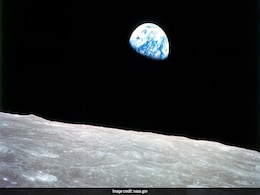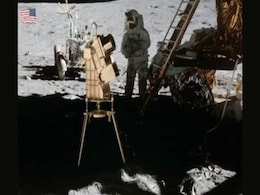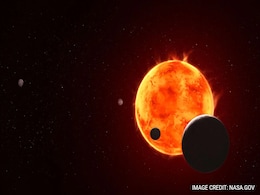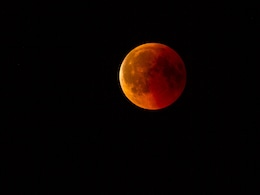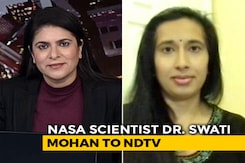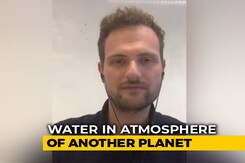Earth Atmosphere
- All
- News
- Videos
- Web Stories
-

Venus' Winds Race Around The Planet At Extreme Speeds Due To Solar Heat
- Sunday November 30, 2025
- Science | Edited by Astitva Raj
New findings suggest that diurnal tides, driven by solar heat, are a major contributor to the extreme speeds of Venus's winds.
-
 www.ndtv.com
www.ndtv.com
-

Sun Unleashes Strongest Flare of 2025, Causing Global Radio Blackouts
- Thursday November 13, 2025
- Written by Gadgets 360 Staff
On Nov. 11, 2025, the Sun erupted with an X5.1-class flare, disrupting shortwave communications across Africa and Europe. The flare’s X-rays and UV radiation ionized Earth’s upper atmosphere, causing R3-level radio blackouts. NOAA warned that a coronal mass ejection could reach Earth on Nov. 12, potentially triggering strong geomagnetic storms ...
-
 www.gadgets360.com
www.gadgets360.com
-

Scientists Create Earth's Most Accurate Digital Twin To Date, Could Revolutionise Climate Modelling
- Wednesday November 12, 2025
- Science | Edited by Ritu Singh
The model operates at a 1.25-kilometer resolution, a massive improvement over traditional models that typically have a 40-kilometer resolution.
-
 www.ndtv.com
www.ndtv.com
-

ESCAPADE Mission: NASA To Send Twin Orbiters To Decode Mars' Magnetic Mysteries
- Wednesday November 5, 2025
- Science | Edited by Ritu Singh
The mission is scheduled to launch on November 9, aboard Blue Origin's New Glenn rocket from Cape Canaveral Space Force Station in Florida.
-
 www.ndtv.com
www.ndtv.com
-

'Halloween Fireballs' Could Threaten Earth In 2032 And 2036, Astronomers Warn
- Sunday November 2, 2025
- Science | Edited by Astitva Raj
Recent research indicates that larger objects in the Taurid stream could pose a greater threat in 2032 and 2036, potentially exploding in the atmosphere or occasionally reaching the Earth's surface.
-
 www.ndtv.com
www.ndtv.com
-

Hubble Observes Massive Stellar Eruption from EK Draconis, Hinting at Life’s Origins
- Sunday November 2, 2025
- Written by Gadgets 360 Staff
Astronomers using the Hubble Space Telescope observed a huge solar storm from EK Draconis, a young Sun-like star. The eruption’s energy may trigger atmospheric chemistry, forming greenhouse gases and organic molecules. Such events could mirror early solar activity that helped spark life on ancient Earth and distant exoplanets.
-
 www.gadgets360.com
www.gadgets360.com
-

Northern Lights Could Be Visible in These US States Tonight, How To See Them
- Wednesday October 29, 2025
- Science | Edited by Ritu Singh
The northern lights are caused by geomagnetic storms, which occur when charged particles from the sun collide with gases in Earth's atmosphere, creating brilliant waves of light in the sky.
-
 www.ndtv.com
www.ndtv.com
-

Atmospheric Carbon Dioxide Soars to 424PPM, Marking Biggest Yearly Jump Ever
- Friday October 17, 2025
- Written by Gadgets 360 Staff
The WMO reports Earth’s atmospheric CO₂ reached 422.8 ppm in 2024 — the biggest annual rise ever recorded. Driven by fossil-fuel emissions, wildfires, and weakening carbon sinks, the surge intensifies global warming. Scientists warn that delayed emission cuts could entrench irreversible changes in weather, ecosystems, and sea levels.
-
 www.gadgets360.com
www.gadgets360.com
-

Starlink Satellites Falling To Earth Raise Fears Of Space Junk "Chain Reaction"
- Wednesday October 15, 2025
- Science | Edited by Amit Chaturvedi
While SpaceX's Starlink network has revolutionised global connectivity, its rapid expansion adds to growing congestion in orbit.
-
 www.ndtv.com
www.ndtv.com
-

Moon Is Rusting: Scientists Stunned By Hematite Discovery On Lunar Surface
- Wednesday September 24, 2025
- Science | Edited by Srishti Singh Sisodia
Understanding of rusting could impact future lunar missions, resource utilisation and equipment design.
-
 www.ndtv.com
www.ndtv.com
-

NASA Prepares 2025 Carruthers Mission to Explore Earth’s Hidden Hydrogen Halo
- Friday September 26, 2025
- Written by Gadgets 360 Staff
NASA’s Carruthers Geocorona Observatory, launching in 2025, will capture ultraviolet light from hydrogen atoms to map Earth’s faint geocorona. Operating a million miles sunward, it will study how solar activity drives atmospheric loss, improves satellite protection, and reveals clues to planetary habitability, providing critical insight for fut...
-
 www.gadgets360.com
www.gadgets360.com
-

Not Like Venus Or Mars, Distant Exoplanet May Have Atmosphere Like Earth's
- Friday September 19, 2025
- World News | Edited by NDTV News Desk
A distant exoplanet might have an atmosphere similar to Earth's, early observations from the James Webb Space Telescope (JWST) suggest. It is part of a group of planets orbiting a star called TRAPPIST-1, about 40 light-years away from Earth.
-
 www.ndtv.com
www.ndtv.com
-

NASA Confirms Discovery of 6,000 Exoplanets Beyond Our Solar System
- Sunday September 21, 2025
- Written by Gadgets 360 Staff
NASA has confirmed 6,000 exoplanets beyond our solar system, highlighting three decades of accelerating discovery. From scorching hot Jupiters to worlds with jewel-like clouds, the catalog reflects cosmic diversity. Future missions aim to identify true Earth analogs and investigate signs of life across distant planetary systems.
-
 www.gadgets360.com
www.gadgets360.com
-

'Mummy Said Don't Go Out': Lunar Eclipse Triggers Hilarious Meme Fest As Moon Turns Blood Red
- Monday September 8, 2025
- Offbeat | Edited by Abhinav Singh
Lunar Eclipse 2025: As the Moon turned blood red, social media users quickly jumped into action by posting hilarious memes and jokes.
-
 www.ndtv.com
www.ndtv.com
-

Venus' Winds Race Around The Planet At Extreme Speeds Due To Solar Heat
- Sunday November 30, 2025
- Science | Edited by Astitva Raj
New findings suggest that diurnal tides, driven by solar heat, are a major contributor to the extreme speeds of Venus's winds.
-
 www.ndtv.com
www.ndtv.com
-

Sun Unleashes Strongest Flare of 2025, Causing Global Radio Blackouts
- Thursday November 13, 2025
- Written by Gadgets 360 Staff
On Nov. 11, 2025, the Sun erupted with an X5.1-class flare, disrupting shortwave communications across Africa and Europe. The flare’s X-rays and UV radiation ionized Earth’s upper atmosphere, causing R3-level radio blackouts. NOAA warned that a coronal mass ejection could reach Earth on Nov. 12, potentially triggering strong geomagnetic storms ...
-
 www.gadgets360.com
www.gadgets360.com
-

Scientists Create Earth's Most Accurate Digital Twin To Date, Could Revolutionise Climate Modelling
- Wednesday November 12, 2025
- Science | Edited by Ritu Singh
The model operates at a 1.25-kilometer resolution, a massive improvement over traditional models that typically have a 40-kilometer resolution.
-
 www.ndtv.com
www.ndtv.com
-

ESCAPADE Mission: NASA To Send Twin Orbiters To Decode Mars' Magnetic Mysteries
- Wednesday November 5, 2025
- Science | Edited by Ritu Singh
The mission is scheduled to launch on November 9, aboard Blue Origin's New Glenn rocket from Cape Canaveral Space Force Station in Florida.
-
 www.ndtv.com
www.ndtv.com
-

'Halloween Fireballs' Could Threaten Earth In 2032 And 2036, Astronomers Warn
- Sunday November 2, 2025
- Science | Edited by Astitva Raj
Recent research indicates that larger objects in the Taurid stream could pose a greater threat in 2032 and 2036, potentially exploding in the atmosphere or occasionally reaching the Earth's surface.
-
 www.ndtv.com
www.ndtv.com
-

Hubble Observes Massive Stellar Eruption from EK Draconis, Hinting at Life’s Origins
- Sunday November 2, 2025
- Written by Gadgets 360 Staff
Astronomers using the Hubble Space Telescope observed a huge solar storm from EK Draconis, a young Sun-like star. The eruption’s energy may trigger atmospheric chemistry, forming greenhouse gases and organic molecules. Such events could mirror early solar activity that helped spark life on ancient Earth and distant exoplanets.
-
 www.gadgets360.com
www.gadgets360.com
-

Northern Lights Could Be Visible in These US States Tonight, How To See Them
- Wednesday October 29, 2025
- Science | Edited by Ritu Singh
The northern lights are caused by geomagnetic storms, which occur when charged particles from the sun collide with gases in Earth's atmosphere, creating brilliant waves of light in the sky.
-
 www.ndtv.com
www.ndtv.com
-

Atmospheric Carbon Dioxide Soars to 424PPM, Marking Biggest Yearly Jump Ever
- Friday October 17, 2025
- Written by Gadgets 360 Staff
The WMO reports Earth’s atmospheric CO₂ reached 422.8 ppm in 2024 — the biggest annual rise ever recorded. Driven by fossil-fuel emissions, wildfires, and weakening carbon sinks, the surge intensifies global warming. Scientists warn that delayed emission cuts could entrench irreversible changes in weather, ecosystems, and sea levels.
-
 www.gadgets360.com
www.gadgets360.com
-

Starlink Satellites Falling To Earth Raise Fears Of Space Junk "Chain Reaction"
- Wednesday October 15, 2025
- Science | Edited by Amit Chaturvedi
While SpaceX's Starlink network has revolutionised global connectivity, its rapid expansion adds to growing congestion in orbit.
-
 www.ndtv.com
www.ndtv.com
-

Moon Is Rusting: Scientists Stunned By Hematite Discovery On Lunar Surface
- Wednesday September 24, 2025
- Science | Edited by Srishti Singh Sisodia
Understanding of rusting could impact future lunar missions, resource utilisation and equipment design.
-
 www.ndtv.com
www.ndtv.com
-

NASA Prepares 2025 Carruthers Mission to Explore Earth’s Hidden Hydrogen Halo
- Friday September 26, 2025
- Written by Gadgets 360 Staff
NASA’s Carruthers Geocorona Observatory, launching in 2025, will capture ultraviolet light from hydrogen atoms to map Earth’s faint geocorona. Operating a million miles sunward, it will study how solar activity drives atmospheric loss, improves satellite protection, and reveals clues to planetary habitability, providing critical insight for fut...
-
 www.gadgets360.com
www.gadgets360.com
-

Not Like Venus Or Mars, Distant Exoplanet May Have Atmosphere Like Earth's
- Friday September 19, 2025
- World News | Edited by NDTV News Desk
A distant exoplanet might have an atmosphere similar to Earth's, early observations from the James Webb Space Telescope (JWST) suggest. It is part of a group of planets orbiting a star called TRAPPIST-1, about 40 light-years away from Earth.
-
 www.ndtv.com
www.ndtv.com
-

NASA Confirms Discovery of 6,000 Exoplanets Beyond Our Solar System
- Sunday September 21, 2025
- Written by Gadgets 360 Staff
NASA has confirmed 6,000 exoplanets beyond our solar system, highlighting three decades of accelerating discovery. From scorching hot Jupiters to worlds with jewel-like clouds, the catalog reflects cosmic diversity. Future missions aim to identify true Earth analogs and investigate signs of life across distant planetary systems.
-
 www.gadgets360.com
www.gadgets360.com
-

'Mummy Said Don't Go Out': Lunar Eclipse Triggers Hilarious Meme Fest As Moon Turns Blood Red
- Monday September 8, 2025
- Offbeat | Edited by Abhinav Singh
Lunar Eclipse 2025: As the Moon turned blood red, social media users quickly jumped into action by posting hilarious memes and jokes.
-
 www.ndtv.com
www.ndtv.com











